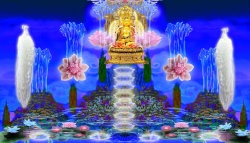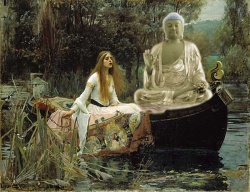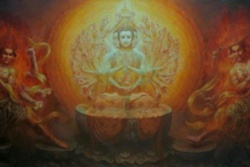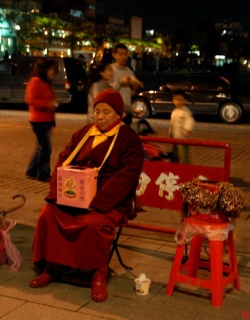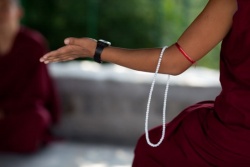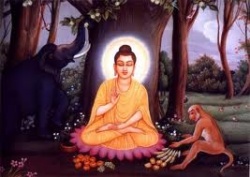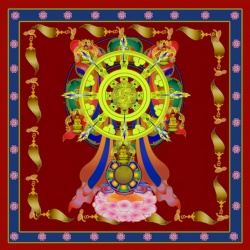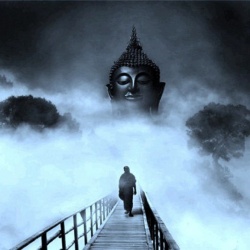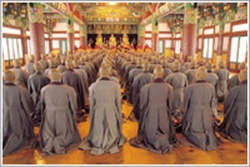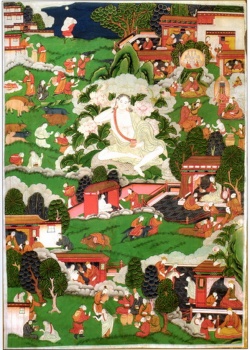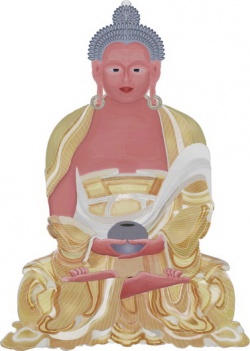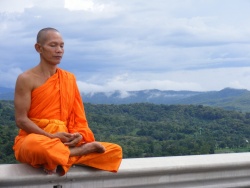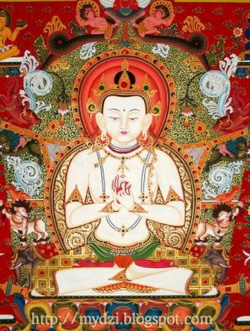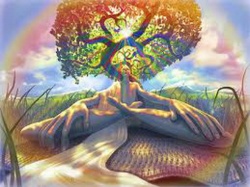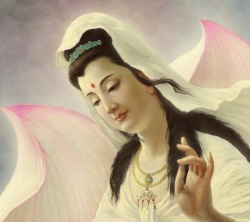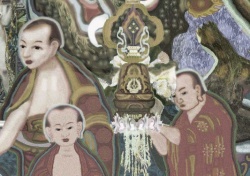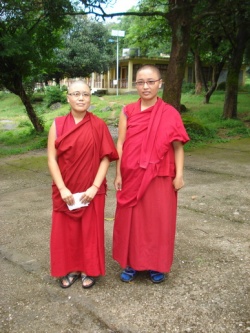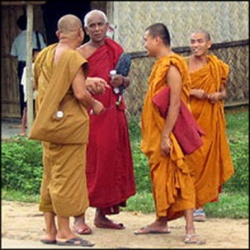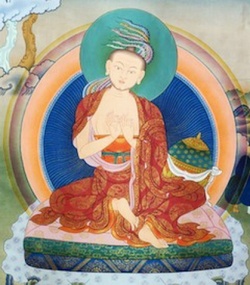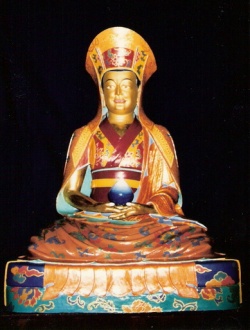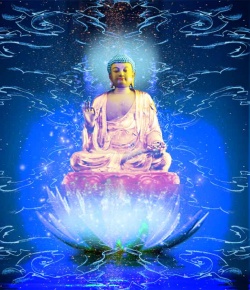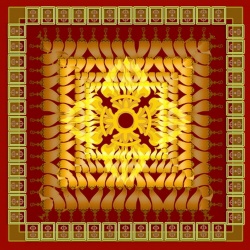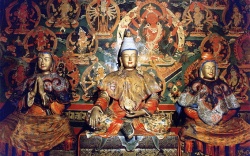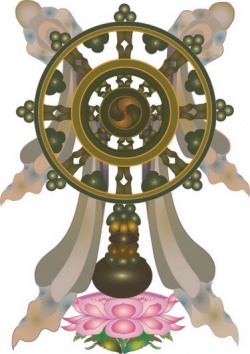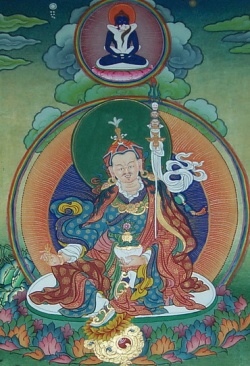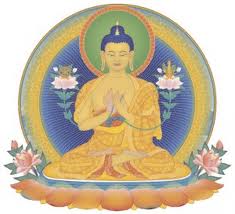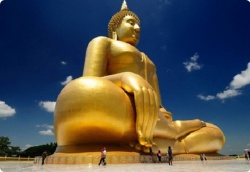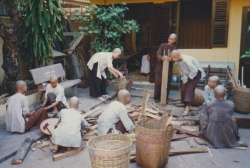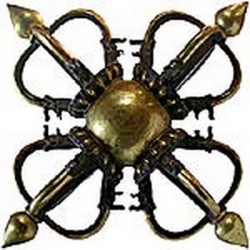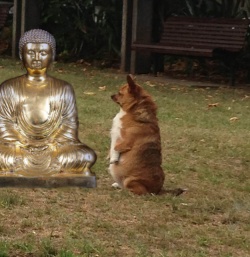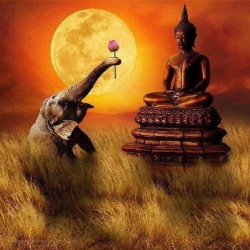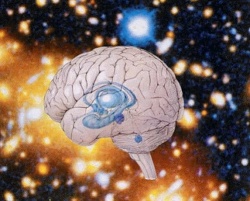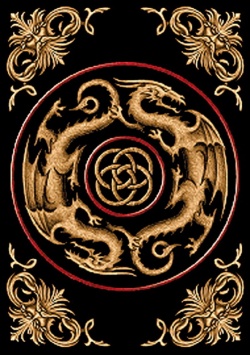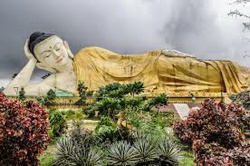Difference between revisions of "Mandala – dKyil-‘khor"
m (Text replacement - "1" to "1") |
|||
| (One intermediate revision by one other user not shown) | |||
| Line 32: | Line 32: | ||
[[Attachment]] and [[desire]] can be quite varied, because there are so many things to [[crave]]; for example, some [[people]] are [[attached]] to [[wealth]], others are preoccupied with their [[physical]] fitness, or their career, or their home, or their [[family]], or their friends. | [[Attachment]] and [[desire]] can be quite varied, because there are so many things to [[crave]]; for example, some [[people]] are [[attached]] to [[wealth]], others are preoccupied with their [[physical]] fitness, or their career, or their home, or their [[family]], or their friends. | ||
| − | So, there have to be just as many methods and means to pacify and eliminate the never-ending problems that arise from [[craving]] and [[attachment]]. | + | So, there have to be just as many [[methods]] and means to pacify and eliminate the never-ending problems that arise from [[craving]] and [[attachment]]. |
| Line 60: | Line 60: | ||
My wife is 100 times, no, 1000 times more [[beautiful]] than that monkey.” | My wife is 100 times, no, 1000 times more [[beautiful]] than that monkey.” | ||
| − | Then, through his miraculous ability, [[Lord Buddha]] led Gawo into a [[celestial realm]]. | + | Then, through his miraculous ability, [[Lord Buddha]] led [[Gawo]] into a [[celestial realm]]. |
Having arrived, the [[Buddha]] pointed to the most [[beautiful]] [[goddesses]] imaginable and asked [[Gawo]], “Who is more [[beautiful]], [[Pundarika]] or these [[goddesses]]?” | Having arrived, the [[Buddha]] pointed to the most [[beautiful]] [[goddesses]] imaginable and asked [[Gawo]], “Who is more [[beautiful]], [[Pundarika]] or these [[goddesses]]?” | ||
| Line 71: | Line 71: | ||
| − | During [[visualization practice]], the {{Wiki|environment}} is also [[perceived]] differently in that a yidam’s [[realm of existence]] is [[visualized]] as a [[pure]] palace and the {{Wiki|environment}} as a [[pure land]]. | + | During [[visualization practice]], the {{Wiki|environment}} is also [[perceived]] differently in that a [[yidam’s]] [[realm of existence]] is [[visualized]] as a [[pure]] palace and the {{Wiki|environment}} as a [[pure land]]. |
[[Visualizing]] the [[outer form]] of a [[yidam]] is practiced so that the veils and [[distortions]] [[arising]] from ceaseless struggles about one’s [[own]] {{Wiki|environment}} are overcome. | [[Visualizing]] the [[outer form]] of a [[yidam]] is practiced so that the veils and [[distortions]] [[arising]] from ceaseless struggles about one’s [[own]] {{Wiki|environment}} are overcome. | ||
| Line 133: | Line 133: | ||
Sooner or later we discover that our [[pleasures]] were episodes of the {{Wiki|past}}, and we are [[miserable]] again. | Sooner or later we discover that our [[pleasures]] were episodes of the {{Wiki|past}}, and we are [[miserable]] again. | ||
| − | [[Dharma]] is {{Wiki|stable}}; it doesn’t [[cause]] us to [[experience]] a little [[suffering]] here, a little [[joy]] there, rather the [[practice]] of [[Dharma]] - together with receiving teachings and contemplating them - gives rise to genuine [[happiness]] and ease. | + | [[Dharma]] is {{Wiki|stable}}; it doesn’t [[cause]] us to [[experience]] a little [[suffering]] here, a little [[joy]] there, rather the [[practice]] of [[Dharma]] - together with receiving teachings and [[contemplating]] them - gives rise to genuine [[happiness]] and ease. |
The [[Dharma]] certainly can be our [[guide]] and escort on the journey of leading an enriched [[life]] that is defined by [[goodness]] and worth. | The [[Dharma]] certainly can be our [[guide]] and escort on the journey of leading an enriched [[life]] that is defined by [[goodness]] and worth. | ||
| Line 195: | Line 195: | ||
| − | In general, everything is by [[nature]] free of [[being]] [[pure]] or [[impure]]. If seen impurely, [[appearances]] [[manifest]] impurely to such a [[person]], because he or she has given free | + | In general, everything is by [[nature]] free of [[being]] [[pure]] or [[impure]]. If seen impurely, [[appearances]] [[manifest]] impurely to such a [[person]], because he or she has given free reign to [[karmic]] {{Wiki|tendencies}} that obscure [[pure perception]] and [[cognition]]. |
In such cases, [[appearances]] do [[manifest]] as a menace; they can even be seen as a threat. Those living in what is defined as the [[hell realm]] really [[experience]] the very expression of their [[own]] [[hatred]] or [[anger]]. | In such cases, [[appearances]] do [[manifest]] as a menace; they can even be seen as a threat. Those living in what is defined as the [[hell realm]] really [[experience]] the very expression of their [[own]] [[hatred]] or [[anger]]. | ||
| Line 226: | Line 226: | ||
The first outer circle of the [[mandala]] is a wall of [[fire]] and is usually painted in the five [[primary]] colours. | The first outer circle of the [[mandala]] is a wall of [[fire]] and is usually painted in the five [[primary]] colours. | ||
| − | The [[mandala]] we are discussing, though, only has a red ring of [[fire]], which [[symbolizes]] the transmutation of [[anger]]. | + | The [[mandala]] we are discussing, though, only has a [[red]] ring of [[fire]], which [[symbolizes]] the transmutation of [[anger]]. |
A [[mandala]] with a multi-coloured outer ring depicts the transmutation of all five [[mental]] [[emotions]] into the finest [[wisdoms]] of [[jnana]].8 | A [[mandala]] with a multi-coloured outer ring depicts the transmutation of all five [[mental]] [[emotions]] into the finest [[wisdoms]] of [[jnana]].8 | ||
| Line 277: | Line 277: | ||
| − | [[Student]]: What are the jnanas of the rings you described? | + | [[Student]]: What are the [[jnanas]] of the rings you described? |
| Line 370: | Line 370: | ||
While the [[mind]] is [[impure]], i.e., while the [[mind]] is obscured by [[karmic]] latencies and fixations, outer [[appearances]] seem to [[manifest]] three aspects: (1) one’s {{Wiki|environment}}, (2) [[objects]], and (3) one’s [ | While the [[mind]] is [[impure]], i.e., while the [[mind]] is obscured by [[karmic]] latencies and fixations, outer [[appearances]] seem to [[manifest]] three aspects: (1) one’s {{Wiki|environment}}, (2) [[objects]], and (3) one’s [ | ||
| − | [own]] [[body]]. | + | [[[own]]]] [[body]]. |
Environment refers to the country and surroundings in which one is born due to previous [[causes and conditions]]. So the [[quality]] of one’s {{Wiki|environment}} depends upon the [[actions]] performed in previous [[lives]]. | Environment refers to the country and surroundings in which one is born due to previous [[causes and conditions]]. So the [[quality]] of one’s {{Wiki|environment}} depends upon the [[actions]] performed in previous [[lives]]. | ||
| Line 441: | Line 441: | ||
The walls of the residence of a [[yidam]] are painted or strewn with [[precious]] {{Wiki|substances}} in the {{Wiki|colour}} that corresponds with the [[direction]], the centre [[being]] in the fifth {{Wiki|colour}}. | The walls of the residence of a [[yidam]] are painted or strewn with [[precious]] {{Wiki|substances}} in the {{Wiki|colour}} that corresponds with the [[direction]], the centre [[being]] in the fifth {{Wiki|colour}}. | ||
| − | The [[five precious substances]] that are used to create and [[visualize]] a [[sand mandala]] are {{Wiki|gold}} for [[yellow]], {{Wiki|crystal}} for white, [[lapis lazuli]] for blue, {{Wiki|ruby}} for red, and {{Wiki|emerald}} for green. | + | The [[five precious substances]] that are used to create and [[visualize]] a [[sand mandala]] are {{Wiki|gold}} for [[yellow]], {{Wiki|crystal}} for white, [[lapis lazuli]] for blue, {{Wiki|ruby}} for [[red]], and {{Wiki|emerald}} for [[green]]. |
The entire palace (the pillars, walls, and baldachins) of a [[sand mandala]] is made of these [[precious]] {{Wiki|substances}}. | The entire palace (the pillars, walls, and baldachins) of a [[sand mandala]] is made of these [[precious]] {{Wiki|substances}}. | ||
| Line 447: | Line 447: | ||
Why is the palace made of [[precious gems]]? | Why is the palace made of [[precious gems]]? | ||
| − | Since we estimate their value higher than [[earth]], [[water]], or metals that lie around for the taking, we treat [[precious gems]] and priceless metals with much more care. Is the exquisite palace therefore only open for the wealthy and rich? No, not at all. Each [[precious]] [[substance]] is associated with a [[transformation]] of a specific [[mind]] [[poison]] into [[one of the five wisdoms]]. | + | Since we estimate their value higher than [[earth]], [[water]], or metals that lie around for the taking, we treat [[precious gems]] and priceless metals with much more [[care]]. Is the exquisite palace therefore only open for the wealthy and rich? No, not at all. Each [[precious]] [[substance]] is associated with a [[transformation]] of a specific [[mind]] [[poison]] into [[one of the five wisdoms]]. |
| Line 479: | Line 479: | ||
| − | In [[order]] to [[manifest]] the [[pure]] centre within one’s [[mind]] that is not dissociated from the [[pure realm]], one [[meditates]] that a sun-disc lies on the [[throne]]. On top of the sun-disc lies a moon-disc. | + | In [[order]] to [[manifest]] the [[pure]] centre within one’s [[mind]] that is not dissociated from the [[pure realm]], one [[meditates]] that a [[sun-disc]] lies on the [[throne]]. On top of the [[sun-disc]] lies a [[moon-disc]]. |
As long as one’s [[cognition]] is [[impure]], one merely [[thinks]] that both {{Wiki|sun}} and [[moon]] have the [[power]] to dispel {{Wiki|darkness}} during the day and, respectively, during the night. | As long as one’s [[cognition]] is [[impure]], one merely [[thinks]] that both {{Wiki|sun}} and [[moon]] have the [[power]] to dispel {{Wiki|darkness}} during the day and, respectively, during the night. | ||
| Line 505: | Line 505: | ||
After having given rise in one’s [[imagination]] to the entire [[realm]] of the [[mandala]] and the [[yidams]] in the [[pure]] palace, a [[practitioner]] now imagines that the [[yidam’s]] [[pure]] [[form]] radiates [[light]] out to invite the [[jnanas]] ([[ye-she-pa]] in Tibetan).14 | After having given rise in one’s [[imagination]] to the entire [[realm]] of the [[mandala]] and the [[yidams]] in the [[pure]] palace, a [[practitioner]] now imagines that the [[yidam’s]] [[pure]] [[form]] radiates [[light]] out to invite the [[jnanas]] ([[ye-she-pa]] in Tibetan).14 | ||
| − | The [[practice]] of inviting the ye-she-pa to enter the [[mandala]] and unite with the [[yidam]] serves two purposes: | + | The [[practice]] of inviting the [[ye-she-pa]] to enter the [[mandala]] and unite with the [[yidam]] serves two purposes: |
(1) one immediately receives the [[blessings]] of the [[buddhas]] and [[bodhisattvas]] and, furthermore, | (1) one immediately receives the [[blessings]] of the [[buddhas]] and [[bodhisattvas]] and, furthermore, | ||
| Line 573: | Line 573: | ||
May [[virtue]] increase! | May [[virtue]] increase! | ||
| − | With {{Wiki|sincere}} [[gratitude]] to Lee [[Miracle]], Director of [[Karma]] [[Mahasidda]] Ling in Idyllwild for managing and assisting so patiently with the website of Ven. [[Thrangu Rinpoche]]. Transcribed and edited by Gaby Hollmann, 2002/2007, responsible for any mistakes. | + | With {{Wiki|sincere}} [[gratitude]] to Lee [[Miracle]], Director of [[Karma]] [[Mahasidda]] Ling in Idyllwild for managing and assisting so patiently with the website of Ven. [[Thrangu Rinpoche]]. Transcribed and edited by [[Gaby Hollmann]], 2002/2007, responsible for any mistakes. |
| − | 1 [[Yidam]] means ‘to commit oneself, to set one’s [[mind]] on something.” The [[word]] yid means ‘the [[conceptual mind]],” and the [[word]] dam means “to commit.” [[Yidams]] are the [[transcendental]] aspects of one’s commitment. - | + | 1 [[Yidam]] means ‘to commit oneself, to set one’s [[mind]] on something.” The [[word]] yid means ‘the [[conceptual mind]],” and the [[word]] [[dam]] means “to commit.” [[Yidams]] are the [[transcendental]] aspects of one’s commitment. - |
For readers studying the [[Tibetan language]], [[yid-dam-la-brten-pa]] is “the firm adherence to one’s [[word]],” [[yid-dam-len-pa]] is “taking the [[vow]].” | For readers studying the [[Tibetan language]], [[yid-dam-la-brten-pa]] is “the firm adherence to one’s [[word]],” [[yid-dam-len-pa]] is “taking the [[vow]].” | ||
| Line 656: | Line 656: | ||
(6) to be enslaved or controlled by others; | (6) to be enslaved or controlled by others; | ||
| − | (7) to [[practice]] only for the sake of [[protection]] from dangers; (8) to [[practice]] a mere semblance of the [[Dharma]] for the sake of gain and [[fame]]. The second ones are: | + | (7) to [[practice]] only for the [[sake]] of [[protection]] from dangers; (8) to [[practice]] a mere semblance of the [[Dharma]] for the [[sake]] of gain and [[fame]]. The second ones are: |
(1) To be [[fettered]] by one's [[family]], [[wealth]] and occupations so that one does not have the leisure to [[practice]] the [[dharma]]; | (1) To be [[fettered]] by one's [[family]], [[wealth]] and occupations so that one does not have the leisure to [[practice]] the [[dharma]]; | ||
| Line 670: | Line 670: | ||
(8) having entered the [[extraordinary]] [[path]] of the [[vajrayana]], to have broken one's [[samaya]] with one's [[teacher]] and [[vajra]] brothers and sisters, and thus have no chance of achieving any [[realization]].” [[Matthieu Ricard]], [[Eight conditions]], in: Rywiki.org, 2006. | (8) having entered the [[extraordinary]] [[path]] of the [[vajrayana]], to have broken one's [[samaya]] with one's [[teacher]] and [[vajra]] brothers and sisters, and thus have no chance of achieving any [[realization]].” [[Matthieu Ricard]], [[Eight conditions]], in: Rywiki.org, 2006. | ||
| − | 11 See [[Milarepa]], “Eight Things to Remember,” “Twelve Kinds of [[Yogic]] [[Joy]],” and “Thirty-Three Kinds of [[Yogic]] [[Joy]],” in: Selected Songs of [[Realization]], as [[taught]] by [[Khenpo Tsultrim Gyamsto Rinpoche]]. Translated & arranged by Jim Scott, Aktuell-Copy-Shop, [[Hamburg]], 1996. | + | 11 See [[Milarepa]], “Eight Things to Remember,” “Twelve Kinds of [[Yogic]] [[Joy]],” and “Thirty-Three Kinds of [[Yogic]] [[Joy]],” in: Selected Songs of [[Realization]], as [[taught]] by [[Khenpo Tsultrim Gyamsto Rinpoche]]. Translated & arranged by [[Jim Scott]], Aktuell-Copy-Shop, [[Hamburg]], 1996. |
12 For a detailed description of the [[five wisdoms]], see [[Khenchen Thrangu Rinpoche]], Transcending [[Ego]]: Distinguishing [[Consciousness]] from [[Wisdom]]. Translated by [[Peter Roberts]], [[Namo Buddha]] Publications, Boulder, 2001. | 12 For a detailed description of the [[five wisdoms]], see [[Khenchen Thrangu Rinpoche]], Transcending [[Ego]]: Distinguishing [[Consciousness]] from [[Wisdom]]. Translated by [[Peter Roberts]], [[Namo Buddha]] Publications, Boulder, 2001. | ||
Latest revision as of 01:33, 7 January 2024
Translated by Peter Roberts
Introduction
When the precious Buddhadharma is being imparted it is very important for students to receive the teachings with the pure motivation, which is the wish to benefit all living beings without exception and to lead them to reliable happiness and peace.
The motivation should not be restricted to those one likes by thinking, “Oh, I only want to help my family and friends.”
The pure motivation of love and compassion embraces all living beings. How is the vast motivation cultivated? By sincerely following the path of Dharma.
Love and compassion can be developed and increased and then one will be able to help others most beneficially. Love and compassion can only be effective if one is impartial.
Blind compassion means directing one’s compassion towards a few at the painful expense of others. Therefore it is important to always remember that true help can only be given if it is authentic.
We earnestly generate the wish to develop and increase the altruistic motivation and know that we are receiving the pure teachings in order to learn to serve others without ego-fixation.
Everyone has inner and outer conflicts and runs up against personal barriers, which vary from one person to the next. Many people lead their lives reigned by their anger, others are jealous or proud, but a major conflict people have in common is desire.
Attachment and desire can be quite varied, because there are so many things to crave; for example, some people are attached to wealth, others are preoccupied with their physical fitness, or their career, or their home, or their family, or their friends.
So, there have to be just as many methods and means to pacify and eliminate the never-ending problems that arise from craving and attachment.
Meditation Deities – Yid-dam
In general, the Tibetan Tradition teaches that meditating on a very beautiful and peaceful form of a deity, yidam in Tibetan,1 is an opportunity to turn one’s attention towards values of being instead of upon one’s personal objects of desire.
Furthermore, it is taught that meditating on a wrathful yidam is a skilful method to focus one’s attention on goodness instead of on one’s own anger.
We can easily see for ourselves in which way concentrating and meditating on an extremely beautiful and extraordinary form diminishes and eventually eradicates attachment and desire for less appealing persons or objects one would otherwise have in mind.
Let me tell you a story to illustrate remedies on how to put an end to the nagging struggles that desire and aversion always bring on.
Lord Buddha had a cousin named Gawo.2 The Buddha saw that it was time to introduce Gawo to the meaningful path of the precious Dharma. There was a problem, though. Gawo was married to a gorgeous woman called Pundarika, and they were madly in love with each other.
Seeing that Gawo would have to become a monk in order to engage in a meaningful life, the Buddha managed to persuade him and finally the day arrived to pick him up to leave mundane concerns behind.
Pundarika was terribly upset; she cried her eyes out and made her husband promise that he would return soon. Off and on their way, Gawo just couldn’t get Pundarika out of his mind.
The Buddha exhorted Gawo, told him that clinging to samsara was the most useless thing in the world – to no avail. Poor Gawo just could not stop thinking of beautiful Pundarika. Lord Buddha decided to lead Gawo into a dense forest.
When they arrived, he pointed to a female monkey and asked Gawo, “Who is more beautiful, Pundarika or that monkey?” Gawo was shocked and answered, “There is no comparison.
My wife is 100 times, no, 1000 times more beautiful than that monkey.”
Then, through his miraculous ability, Lord Buddha led Gawo into a celestial realm.
Having arrived, the Buddha pointed to the most beautiful goddesses imaginable and asked Gawo, “Who is more beautiful, Pundarika or these goddesses?”
The moment Gawo caught sight of these women, his attachment to his wife vanished and he did not even take the time to answer the question that Lord Buddha asked - that is how overwhelmed he was.
This is the idea behind meditating peaceful and beautiful yidams; it is also the purpose of meditating on wrathful deities too, namely, in order to tame and eventually overcome one’s own emotional mind that is so disruptive and harmful.
These instructions deal with the outer form of the yidam.
During visualization practice, the environment is also perceived differently in that a yidam’s realm of existence is visualized as a pure palace and the environment as a pure land.
Visualizing the outer form of a yidam is practiced so that the veils and distortions arising from ceaseless struggles about one’s own environment are overcome.
Visualizing the pure palace and environment of a yidam reduces mental constructs about one’s home and surroundings. Both aspects of meditation give rise to wholesome qualities in one’s mind.
By becoming accustomed to visualizing the outer form of a yidam and the environment as peaceful and pure - instead of succumbing to emotional urgencies - one eradicates frustrating states of mind and develops insight into the true nature of reality, which is and always has been free of any emotional stains and discursiveness that arise. If you have any questions, please ask.
Questions
Student: What does it mean when a disciple sees his or her master as the deity that the master realized, for instance, some disciples saw Lotsawa Marpa as Buddha Chakrasamvara?
Thrangu Rinpoche: This kind of vision that appears quite clearly in the mind of a very devoted disciple is similar to pure perception. It can arise on account of intense faith and devotion in the Guru and his or her yidam, but it is not what is referred to as realizing one’s true nature that is always and already present within.3
Student: It is said that a Buddha has no mental form, but it is said that everyone else has a mental form in the bardo.4
What is a mental form and how does it relate to the yidam?
Does yidam practice transform the mental form? And what happens if one doesn’t reach buddhahood?
Rinpoche: A bardo being has a mental body that only exists as a feeling, a perception; it is merely a projection of former habits. Other than that image, there is no physical body.
So, it is very important to focus one’s mind on the right path while alive, and Dharma certainly teaches us to turn our mind towards the right path, towards what matters most, which is virtue and goodliness.
Dharma is the healing nectar, amrita in Sanskrit, the pure medicine that can transform everything into peace and harmony. Dharma can only cause one to be good and will not bring the least harm to oneself or to other living beings.
The Dharma is very important for oneself, for family members, for societies at large. If people are hypocritical, if people are not sincere and everyone in a group or community is ambitiously concerned about himself or herself, then problems and difficulties will arise and persist.
If people are kind and caring, then relationships will be very harmonious and all involved will be happy and content.
It only takes the presence of one self-centred and selfish person in a group to contaminate others - as a result nobody will be happy.
The Dharma is the source of happiness for oneself as well as for smaller and larger groups.
Seen from every angle, Dharma is the healing nectar that eliminates suffering and pain and brings lasting peace and joy.
But what do we do with the Dharma? Do we have to study it? Yes. Do we have to know it? Yes.
After having listened to the Dharma teachings, it is necessary to study and contemplate the instructions. Is that enough? No. It is necessary to integrate the precious teachings and to manifest them in all our actions and deeds.
Shantideva said that Dharma is like medicine.
If one takes the medicine a doctor prescribes, one can become cured of an illness or disease, but one needs to take the medicine in reliance upon a doctor’s advice.
In the same way, Dharma is medicine that removes suffering and pain, but it must be taken in order to bring beneficial results, which is goodness and well being.
It is not enough to know about it, or to defend it, or to discuss it. One actually needs to experience the truth of the wonderful teachings that Lord Buddha gave us.
Looking at our own lives, it is needless to say that an enormous amount of emotional urgencies arise in us.
We do understand and notice that anger and desire lead to suffering and pain.
We also see that pleasure and happiness are fragile and fluctuate in a fast-moving world.
Sooner or later we discover that our pleasures were episodes of the past, and we are miserable again.
Dharma is stable; it doesn’t cause us to experience a little suffering here, a little joy there, rather the practice of Dharma - together with receiving teachings and contemplating them - gives rise to genuine happiness and ease.
The Dharma certainly can be our guide and escort on the journey of leading an enriched life that is defined by goodness and worth.
Does Dharma only help us personally? No. Transforming ourselves honestly and sincerely through practice actually betters the world we live in and gently inspires and moves our family, colleagues, and friends.
Living in a family or society saturated in self-centred pursuits, in which the ends are thought to justify the means, is contagious and only spells trouble, not joy.
Those individuals who are ruled by their selfish and nagging impulses of anger, desire, greed, and other destructive emotions are so overwhelmed by their impulses that they can hardly be persuaded to disentangle themselves from their unsatisfactory experiences; they can’t even appreciate any occasion to be grateful and share whatever happiness or well-being they have with others.
On the contrary, such self-centred people force anyone associated with them to grudgingly endure their captivity while trying to save a relationship from falling apart, which eventually will happen.
If all members in a family appreciate the Dharma and engage in the practice, then they will be able to live in mutual accord and harmoniously. If they have love and compassion for one another, then everything will work out fine and nobody would need to suffer.
Even within a family, Dharma is the source of harmony and peace.
We are gathered together in a group now, and - whether you are in a group or in your family - I do want to ask you to please always keep the Dharma in mind and to practice the instructions sincerely and during all walks of life.
The Importance of Meditating the Indivisibility of the Outer Environment and the Inner Yidam as the Mandala of One’s Own Mind
I wish to continue speaking about becoming accustomed to visualizing the beauty and purity of both a yidam and its surroundings so that one no longer suffers from the tension of being broken by failure or being bloated by any success one experiences in life.
By becoming accustomed to visualizing the beauty and purity of a yidam and its surroundings, one develops insight into the true nature of reality, which is and always remains untouched by any self-centred ideas or emotions that harm
The real yidam is the true nature of the mind, the buddha within.
The plenitude of the buddha within can unfold and manifest through the compassionate blessing of what is called “sign yidam.”
By understanding the relationship between the outer and inner yidam and by practicing according to the precious instructions, a student can realize the inner nature of the own mind and manifest his or her hidden treasure that is always and already slumbering within.
Meditation practice is more than wishful thinking.
The main yidam in every visualization practice is surrounded by an entourage of images who also represent values of goodness and worth.
They are yidams too, so there is the entire surrounding in which qualities of being manifest in a great variety of ways.
The Sanskrit term mandala can be translated into Tibetan as byin-‘khor, which means “centre and periphery,” i.e., “centre and everything surrounding it, everything taking place within a specific surrounding.”
In the context of yidam meditation, the yidam is the centre and the surrounding is the pure palace and realm of a specific Buddha.6
The idea behind generating and meditating the outer surrounding of a yidam is to realize the inseparable nature of outer objects that are usually apprehended delusively.
By meditating the yidam in the centre and the entire landscape as pure manifestations of being, a practitioner can realize the inseparability of his or her way of seeing the world, the term “world” referring to all objects fit to be apprehended.
The mandala is the visual support during yidam practice, and it varies in each ritual.
There are three-dimensional structures that somewhat resemble architectural models, and each aspect is visualized as part of the entire mandala. Should a three-dimensional mandala not be available for one’s practice, then a drawing can be used to serve as a map to focus one’s attention upon. In that case, the mandala can be painted on a piece of cloth or strewn with coloured kernels on a platform or table.
Many yogis do not need complex structures when visualizing a mandala, so they arrange grains heedfully on a plate as a representation while reciting the prayers, which is sufficient.
In general, everything is by nature free of being pure or impure. If seen impurely, appearances manifest impurely to such a person, because he or she has given free reign to karmic tendencies that obscure pure perception and cognition.
In such cases, appearances do manifest as a menace; they can even be seen as a threat. Those living in what is defined as the hell realm really experience the very expression of their own hatred or anger.
Those living in the hungry-ghost realm really experience the very expression of their own avarice. Animals born in their realm of being live in stupidity and sadly experience the excruciating fear and pain of being devoured alive. One’s own mental state determines the realm one lives in.
What do human beings experience? The realm of human beings is, in fact, the very embodiment of great attachment and desire. Almost every thought we have, every word we speak, and every move we make is based upon our ingrained sense of need.
We always seem to need and therefore want something, and it is just this wanting that determines our actions.
When pleasures have been achieved, we want something else or more because we are bored again, so we perpetuate wanting and do what we can to satisfy our boundless desires, that started to churn the moment we were born and hardly leave us until we die. We are then born again after a short while with the very same inclination.
This never-ending sense of need is in truth desire and attachment that manifests openly through the exterior world that appears to us and through the inner world that we experience.
This is the case for all living beings that live and experience the world as they do, and it is marked by feverish anxiety and woe.
When dissatisfaction has been discerned and misidentifications dissevered, purity naturally unfolds in the mind of a noble practitioner.
Then his or her environment becomes the manifestation of a pure landscape in which there are no discursive thoughts nor mental distortions - a sanctified world that embeds values of worth.
These values are truly experienced by a sincere practitioner.
The Surrounding of the Pure Palace – dKyil –khor-'khor-lo7
The first outer circle of the mandala is a wall of fire and is usually painted in the five primary colours.
The mandala we are discussing, though, only has a red ring of fire, which symbolizes the transmutation of anger.
A mandala with a multi-coloured outer ring depicts the transmutation of all five mental emotions into the finest wisdoms of jnana.8
The next concentric wall of the mandala is a ring of vajras that represent transmutation of ignorance, ignorance being uncertainty brought on by a mistaken apprehension of the way things are and the way things appear. Vajras, on the other hand, are representations of enduring, changeless, and immutable truths.9
Next, there are eight cemeteries encircled by the vajra ring.
The eight funeral grounds represent transmutation of desire and attachment. We saw that desire means being driven by wanting, which leads to never-ending pursuits. The eight funeral grounds symbolize the inner state of being free from wanting as such.10
There are seamless offerings of many kinds within the ring of the cemeteries.
What does this mean?
Dissatisfied with what we have and not content with anything done, frustration burns inside, and the feeling that nothing is right and that there isn’t enough arises, which is an expression of attachment and desire to have more and more.
When desire is transmuted, there is the experience of abundance, and a practitioner is in a state of perfect contentment.
When the mind is richly adorned with content and ease, then anything a practitioner wishes, whether material or spiritual goals, appears automatically.
An entire field of most beautiful offerings is an expression of such a peaceful mind.
Questions
Student: What is the meaning of the eight cemeteries?
Thrangu Rinpoche: They represent the overall transmutation of attachment and desire. In the meditation instructions, there is the practice called “the eight gates to purify desire,” so there are eight cemeteries.
Student: I didn’t understand the symbolism of the offerings.
Rinpoche: In our present state of impurity, we always want more and never have enough.
In a state of purity, one always has enough and therefore needs are automatically fulfilled.
Jetsun Milarepa sang a song to explain this: “When you do not want anything, then you are naturally happy.”11 The offerings symbolize happiness, i.e., freedom from all wants and needs.
They represent the sparkling wealth of pure apprehension in the minds of those who have transcended needs, in the minds of those practitioners who are never again afflicted by a feeling of scarcity.
Therefore the offerings are the most beautiful objects that can be imagined.
It is not a matter of being dead-set on short-lived things, rather the beautiful offerings symbolize freedom from craving and wanting things that cannot possibly ever be better than those offered during mandala practice.
Student: What are the jnanas of the rings you described?
Rinpoche: The outer ring of fire symbolizes the transmutation of anger and corresponds to mirror-like wisdom.
The circle of vajras symbolizes the transmutation of ignorance and corresponds to dharmadhatu wisdom.
The eight cemeteries symbolize the transmutation of desire and correspond to discriminating wisdom.12
Student: Would you speak about the history of the art of making a mandala? Does this mastery originate from India? Are there different visions of the mandala or are you describing that of the Karma Kagyu Lineage? How does the mandala fit into artistic mastery?
Rinpoche: In fact, the origin of mandalas is neither Tibetan nor Indian; rather the mandala is a direct Tantric revelation that Lord Buddha imparted.
In the Tantras, the Buddha taught and explained every detail of mandalas; he defined all measurements; for example, he taught how large the doors should be, how thick the walls should be, and the exact distance between the rings and enclosures.
The tradition on how to paint or build a mandala precisely is meticulously described in the Tantras, so we cannot say that it is Indian or Tibetan.
There are many different kinds of mandalas, each depicting the pure realm of a specific deity. I spoke about the various mind poisons that drive people to experience life the way they do.
I also mentioned that remedies are available to us in the form of the different yidam practices; they are remedies that transform one’s deluded apprehension into pure awareness.
When the various disturbing mental fabrications have been purified and transformed, then all appearances are seen purely, and this is what makes it possible for mandalas to appear in the mind of a noble practitioner.
I am presenting a general description here and am not going into details of the different measurements and sizes.
The general outline I am speaking about now is not specific to the Kagyu Tradition.
This is just a general introduction to the principle of the mandala that all schools of Tibetan Buddhism share.
One feature in making a mandala was developed in India, though.
When mandalas were painted on canvas, the measurements and sizes taught in the Tantras were strictly observed, but there were no guidelines on how to fill in the gaps between the spaces that were drawn with lines.
The tradition of filling in the gaps seems to have originated in Kashmir and spread to Tibet from there.
Slight influences came from Nepal, later also from China, so different ways of filling in the gaps in reliance upon Kashmiri, Nepali, or Chinese artists did flourish.
Also, different ways of filling in the gaps developed in the different traditions in Tibet.
So, various styles of filling in the gaps in a mandala did develop in reliance upon foreign suggestions. No literature states that this missing link originated in Kashmir.
It is only my feeling from what I have been able to see and hear.
Student: Can we ourselves be an independently existing yidam?
Thrangu Rinpoche: The outer yidam is like a bodhisattva or a buddha.
They are symbols that we use to remember that we can achieve the same values that they possess if we practice. Yes, the yidams are really present.
There really are yidams, like Noble Chenrezig, but we cannot say that they exist in the same way that other things exist, because yidams are beyond coarse forms of existence.
Yidams are present in the same way that the Buddha nature is present and aren’t solid existents.
Rather, yidams are the nature of dharmadhatu, which is beyond such concepts as “existent” and “non-existent.” They are present in a form that is beyond form.
Impure and Pure Apprehension
Continuing with the teachings on the mandala, we learned that it is possible to visualize the mandala and that it can be made manifest in a perceivable way. Let me speak about pure and impure apprehensions now.
What takes place when one perceives appearances impurely due to conditionality that is always based on karmic latencies and tendencies within? All appearances manifest as apprehended objects perceived by an apprehending subject.
Exterior objects appear to the mind as though they have a solid reality, i.e., they seem to exist inherently and of their own accord.
The mind itself that cognises is lucid and clear, while, at the same time, it is constantly overwhelmed by appearances and experiences.
The mental consciousness misjudges perceptions by constructing thoughts that are based upon karmic latencies and not upon what is real, and, as a result, all conditioned existents that are apprehended are mistakenly divided into an apprehending mind in opposition to apprehended objects.
While the mind is impure, i.e., while the mind is obscured by karmic latencies and fixations, outer appearances seem to manifest three aspects: (1) one’s environment, (2) objects, and (3) one’s [ [[[own]]]] body.
Environment refers to the country and surroundings in which one is born due to previous causes and conditions. So the quality of one’s environment depends upon the actions performed in previous lives.
For instance, if one engaged in negative actions, the country and surroundings one experiences will be unpleasant and maybe even frightening.
If one engaged in positive actions, the country and surroundings one experiences will be pleasant and beautiful. So, the surroundings one experiences depend upon previous actions.
Apprehending impurely means one thinks appearances are divided into a self and others, and this split engenders negative feelings when it comes to relationships between oneself and the world of appearances.
Impure perception concerns the objects that can be perceived by any of the five sensory faculties that beings are born with, i.e., living beings can perceive forms, sounds, smells, tastes, and tangible objects through their respective sensory organ.
Usually a human being is born with five sensory organs and with the ability to think and speak. In dependence upon karma, one or some sensory faculties can dysfunction, e.g., some people are born blind or handicapped, and therefore they see, hear, smell, taste, and feel differently than others.
So, as long as one clings to ephemeral experiences - outer environment, objects perceived by the senses, and one’s body - everything is experienced impurely, and disturbing emotions arise as a result.
While the mind is deluded, one’s body does cause one to experience suffering and pain, objects become a source of suffering due to fluctuating and unsatisfactory interpretations about self and others, and one’s environment seems divided into “mine,” and “yours,” and “theirs.”
Visualization practices are carried out so that the impure aspects of one’s apprehending mind are transformed into pure perception and cognition.
When practice is perfected, then the environment, the objects perceived by the five senses, as well as one’s body will have become pure, and then all appearances naturally manifest as the radiant mandala.
Perception of an impure surrounding, impure objects, and an impure physical body will be transformed into an experience of radiant purity through mandala and yidam meditation practices. The outer ring of fire, the circle with vajras, and the eight charnel grounds correspond with the environment, i.e., transformation brings forth a pure place.
The palace of the yidams, which I will speak about now, corresponds with the objects that appear to the five senses.
Inner transformation of the faculties that apprehend engenders the pure palace within.
The Palace of the Buddha Within - The Abode of the Yidams
As long as one’s sensory perceptions are impure, objects will be seen as attractive, repelling, or they leave one indifferent. When the five senses are purified, all objects that appear to the mind become the very manifestation of the five types of jnana. This is why any beautiful objects depicted and shown within the pure mandala do not bring on desire or attachment.
The palace itself, the home of the buddhas and yidams, is the pure manifestation of all five jnanas.
In the discussion above, we saw that the palace of the buddha is in the center of the mandala and is surrounded by a vast field of offerings.
The palace of the buddha and yidams was translated into Tibetan to also mean “immeasurable abode,” because it is expansive and unfathomable. 13
The central palace of every mandala is square and has four gates and doors. While in the impure state that is governed by karmic circumstances and conditions, people build their houses according to their personal taste – some people prefer a round house, some a square house, and others would rather live in a rectangular house.
The palace within the mandala is the pure realm in which everything is immaculate and non-differentiate.
Therefore, the residence in every mandala will always be square and have four doors.
Lord Buddha taught the Dharma without deception, without manipulating his disciples in order to win them over or to push them towards the path to liberation.
He only spoke about the true nature of things, just as they appear and are.
What did he teach? The Four Noble Truths.
The square palace symbolizes the Four Noble Truths and is therefore always square.
The four gates or doors symbolize that, due to mind’s fundamental nature and the way things really are, a practitioner can realize the ultimate truth of the centre by passing through one of the four doors, either by entering through the eastern door, the western door, the northern door, or the southern door.
Whoever follows the path of the precious Buddhadharma and passes through one of the four portals will reach liberation, since “All roads lead to Rome” and here, “All ways lead to the mandala’s centre.”
The walls of the residence of a yidam are painted or strewn with precious substances in the colour that corresponds with the direction, the centre being in the fifth colour.
The five precious substances that are used to create and visualize a sand mandala are gold for yellow, crystal for white, lapis lazuli for blue, ruby for red, and emerald for green.
The entire palace (the pillars, walls, and baldachins) of a sand mandala is made of these precious substances.
Why is the palace made of precious gems?
Since we estimate their value higher than earth, water, or metals that lie around for the taking, we treat precious gems and priceless metals with much more care. Is the exquisite palace therefore only open for the wealthy and rich? No, not at all. Each precious substance is associated with a transformation of a specific mind poison into one of the five wisdoms.
As it is, our impure thoughts cause us to react negatively; our negative reactions lead us to commit non-virtuous actions that bring on painful results.
When the entire chain-reaction has collapsed, i.e., been purified, then what were once objects of delusion and attachment no longer give rise to disruptive reactions in the mind of a practitioner, and, as a result, suffering and anguish cease.
For instance, we may think that possessing gold and precious gems will make us happy, so we invest all our time and energy to earn enough money to buy them. While working our heads off to one day be able to pay the price, we endure hardships, stress, and anguish.
Once we have finally managed to buy the jewels and gems we wanted so badly, fear of robbers and inflation that will leave us empty-handed bring on further headaches.
This short account only intends to show how useless such pursuits really are, and that the precious substances are not to blame for all stress and strain one goes through in order to own them; rather attachment and desire bring on the anguish that greed always entails.
The precious substances that adorn the sacred abode of a yidam do not lead to suffering and pain, rather they remain a source of true happiness and joy.
Inside the buddha palace, the yidams are seated on their respective throne, one throne held by a lion that symbolizes the most powerful type of fearlessness.
There are four kinds of fearlessness that relate to oneself and others:
(1) teaching that one abides in enlightenment within all phenomena,
(2) teaching the path,
(3) teaching cessation, and
(4) being beyond dispute.
In order to manifest the pure centre within one’s mind that is not dissociated from the pure realm, one meditates that a sun-disc lies on the throne. On top of the sun-disc lies a moon-disc.
As long as one’s cognition is impure, one merely thinks that both sun and moon have the power to dispel darkness during the day and, respectively, during the night.
In the natural purity of one’s own mind, though, both discs symbolize freedom from the darkness of ignorance. The sun-disc stands for pure means of compassion, and the moon-disc stands for pure wisdom of shunyata, emptiness.
We discussed that while the mind is impure, exterior appearances seem to manifest three aspects:
1) one’s environment, (2) objects, and (3) one’s own body.
The meditation practice of visualizing the offerings that surround the inner palace, the palace walls, the palace gates, thrones, as well as the sun and moon discs purifies the objects that are perceived by any of the first consciousnesses.
Visualizing the yidam that has three aspects is the practice to purify one’s own body. The three aspects are: (1) the symbolical yidam, (2) the sign yidam, and (3) the manifest yidam.
Inviting the Yidam’s Wisdom - the Ye-shes-pa
We saw that meditating the rings that encircle a mandala transforms impure apprehension of one’s environment; meditating the outer structure and inner palace of the buddhas and residence of the yidams transforms cognition of the objects perceived by the five sensory faculties. Meditating the yidam transforms one’s own body. How do we practice the last?
After having given rise in one’s imagination to the entire realm of the mandala and the yidams in the pure palace, a practitioner now imagines that the yidam’s pure form radiates light out to invite the jnanas (ye-she-pa in Tibetan).14
The practice of inviting the ye-she-pa to enter the mandala and unite with the yidam serves two purposes:
(1) one immediately receives the blessings of the buddhas and bodhisattvas and, furthermore, (2) one develops and increases one’s inner potential by realizing and manifesting jnana in its manifold forms.
Through prayer and joyful endeavour that is sustained by devotion, one’s innate wisdom can unfold and blossom, growing more brilliant and sparkling through realizing wisdom as it is.
I will end my instructions for now. You are welcome to ask questions.
Questions
Student: Is there a similar mandala for Milarepa meditation practice?
Thrangu Rinpoche: I have given a general description of yidam practice. For instance, Guru Yoga or Dorje Sempa meditations are simplified practices in which no mandala is needed. In these meditation practices, it is not necessary to visualize a mandala with surroundings and palace; rather, one only imagines the deity in space and many offerings flowing to them.
Student: Mandalas are phases of meditation practice. Are there other mandalas that appear spontaneously as signs of realization? And do they appear differently than the one you described?
Rinpoche: Through proficiency in apprehending purely and through having purified and transformed one’s inhibitions and karmic tendencies into jnana, ye-shes, then the mandala manifests exactly as I described it, because mandalas are the pure realm of a yidam, which is the innate reality of all that appears.
Student: Does the mandala only manifest as sambhogakaya or does it appear as nirmanakaya too?
Rinpoche: Both, because they are form kayas.
Student: Can you tell us how the wrathful form of the deities could come and help? Anger is so strong when things don’t work out.
Rinpoche: Actually, there are two types of meditation practice that help us pacify obstacles. One practice is imagining that everything manifests as your greatest problem and involvement.
The other practice is imagining that everything manifests as the opposite of your greatest problem and involvement. When it comes to desire, attachment, and greed, a practitioner imagines things that are so much more beautiful and exceptional than what he or she usually thinks of.
This practice automatically eradicates attachment and greed for those objects that one usually holds in one’s mind, because they are then deemed worthless.
When it comes to the problem of anger, a practitioner imagines a yidam that is so much more ferocious and terrifying than his or her own anger; then he or she stops being angry and slowly but surely learns to let things be instead of responding in rage.
Student: Can you say something about cultivating the pure view from the moment one wakes up in the morning until one goes back to bed at night?
Rinpoche: Well, you get up, have tea, and enjoy a big breakfast – just kidding. When you get up in the morning, the first thing you can practice is not following after thoughts.
When you go about daily obligations, you try to maintain that thread of awareness. When you talk with people or work, you do not allow your mind to become distracted or carried away.
Improvement comes through practice, and eventually you will be able to abide in a meditative state, from the moment you wake up in the morning until you go to sleep again each night.
Student: (Inaudible.)
Thrangu Rinpoche: There are no fixed numbers of yidams that surround the central buddha.
The number varies in each practice. Sometimes an entourage of eight deities surround a deity; they represent the eight types of consciousness in their pure manifestations.
Sometimes five deities accompany the main yidam; they represent the five purified skandhas. Sometimes as many as fifty-one deities surround the central figure; they represent the purified fifty-one fluctuating mental events.
Thank you very much.
May virtue increase!
With sincere gratitude to Lee Miracle, Director of Karma Mahasidda Ling in Idyllwild for managing and assisting so patiently with the website of Ven. Thrangu Rinpoche. Transcribed and edited by Gaby Hollmann, 2002/2007, responsible for any mistakes.
1 Yidam means ‘to commit oneself, to set one’s mind on something.” The word yid means ‘the conceptual mind,” and the word dam means “to commit.” Yidams are the transcendental aspects of one’s commitment. -
For readers studying the Tibetan language, yid-dam-la-brten-pa is “the firm adherence to one’s word,” yid-dam-len-pa is “taking the vow.”
Furthermore, dam-du-‘dzin means “to hold as supreme,” dam-tshig means “commitment, integrity, union, sacred or solemn vow, engagement made solemnly.”
See Rangjung Yeshe Tibetan-English Dictionary, online. - On this occasion I wish to insert the short gratification noted in the online edition of this most invaluable dictionary: “Nitartha extends thanks to Erik Pema Kunsang (Erik Hein Schmidt) for his permission to use the dictionary, and to Mr. Gerry Wiener and Mr. Demetrius Johnson, who have made the online version of this dictionary possible.”
2 Gawo is Kun-dKha-’bo, the Tibetan name for Ananda, who recited from heart the sutras at the First Council and served as the second patriarch in the oral transmission of the Dharma.
The online dictionary of Pali presents many episodes from his life and writes that Ananda was one of the principal disciples of the Buddha.
3 On another occasion, Thrangu Rinpoche tells us that through practicing the creation stage of meditation, “(…) we are learning to transform our perception into pure appearances.
To achieve this purity, we meditate on the Three Roots.
The Three Roots are
the Guru who is the root of the blessings and the transmission of abilities, the yidams who are the root of spiritual powers (siddhis), and the protectors who are the source of all activities to be accomplished.”
Khenchen Thrangu Rinpoche, The Three Vehicles of Buddhist Practice, Namo Buddha Publications, Crestone, Co., 2003, page 84 (1st ed. Sri Satguru Publications, Delhi, 1994).
See Khenchen Thrangu Rinpoche, Creation & Completion. Essential Points of Tantric Meditation. Introduced, translated, & annotated by Sarah Harding, Wisdom Publications, Boston, 1996, 2002.
4 Bardo (bar-do), “intermediate state or transition” state, commonly refers to the state and lapse of time occurring between death and the next rebirth.
More precisely, one can recognize six bardos: the bardo of birth and life (skye-gnas-bar-do), of meditative concentration (sam-gtan-bar-do), of dream (rmi-lam-bar-do), of the instant of death (‘chi-kha-bar-do), of the absolute nature (chos-nyid-bar-do), and of seeking a new existence (srid-pa-bar-do).
5 Shantideva was the great Mahasiddhas who lived from approximately 685 until 763 AD. He composed the Bodhicharyavatara, “The Way of the Bodhisattva,” which has been translated by the Padmakara Translation Group (Shambhala Publications, Boston & London, 2003).
6 The Rangjung Yeshe Tibetan-English Dictionary tells us that “dkyil-‘khor means ‘centre and surrounding.’ Usually a deity along with its surrounding environment.
A mandala is a symbolic, graphic representation of a tantric deity's realm of existence.” - Furthermore, the word bskor means, “encircle,” and the verb bskor-ba means, “to ring, encircle, surround.”
Byin-pa means, “to give.” Byin-rlabs means “blessings,” it also means “grace, consecrate, stream of empowering energy, potentiality.”
The simultaneous translation of the instructions transcribed here for the word “centre” sounded like byin, which could point to nying-po, the Tibetan equivalent of the root of the Sanskrit term, manda, which means “essence.”
7 dKyil-‘khor-‘khor-lo-yong-rdzogs is “the entire mandala circle.”
8 Jnana is the Sanskrit term that was translated into Tibetan as ye-shes, which means “wisdom, original wakefulness, basic cognisance independent of intellectual constructs.”
There are also the five wisdoms, aspects of how the cognitive quality of Buddha nature functions: dharmadhatu wisdom, mirror-like wisdom, wisdom of equality, discriminating wisdom, and all-accomplishing wisdom.
9 A vajra represents a quality that is so pure and so enduring that it is like a diamond, the reason it was translated do-rje in Tibetan.
10 One list presented in the Ryiwiki Dictionary states that the eight charnel grounds, dur-khrod-brgyad, are:
(1) Cool Grove, Sitavana, in the east,
(2) Perfected in Body to the south,
(3) Lotus Mound to the west,
(4) Lanka Mound to the north,
(5) Spontaneously Accomplished Mound to the south-east,
(6) Display of Great Secret to the south-west,
(7) Pervasive Great Joy to the north-west, and
(8) World Mound to the north-east. -
It is also interesting to note what Matthieu Ricard writes in reliance upon Longchen Rabjam about what is worth burying. He wrote that there are “eight conditions that cause one to drift away from the Dharma and eight conditions that limit one’s natural potential to attain freedom. The first ones are: (1) To be greatly disturbed by the five poisonous emotions;
(2) to be extremely stupid; (3) to fall prey to evil influences; (4) to be distracted by laziness; (5) to lead a wrong way of life; (6) to be enslaved or controlled by others;
(7) to practice only for the sake of protection from dangers; (8) to practice a mere semblance of the Dharma for the sake of gain and fame. The second ones are:
(1) To be fettered by one's family, wealth and occupations so that one does not have the leisure to practice the dharma; (2) to have a wicked nature that leads to extremely bad conduct, so that even when one meets a spiritual teacher it is very hard for one to turn one's mind to the dharma;
(3) to have no fear of the suffering of samsara and therefore no feeling of renunciation or no weariness at all of samsara; (4) to lack the jewel of faith and therefore have no inclination whatsoever to meet a spiritual teacher and enter the threshold of the teachings; (5) to delight in negative actions and have no compunction about them, thus turning one's back to the dharma; (6) to have no more interest in the dharma than a dog for grass and therefore to be unable to develop any positive quality;
(7) to have spoiled one's vows and mahayana precepts, and therefore to be doomed to the lower realms of existence where there is no leisure to practice the dharma;
(8) having entered the extraordinary path of the vajrayana, to have broken one's samaya with one's teacher and vajra brothers and sisters, and thus have no chance of achieving any realization.” Matthieu Ricard, Eight conditions, in: Rywiki.org, 2006.
11 See Milarepa, “Eight Things to Remember,” “Twelve Kinds of Yogic Joy,” and “Thirty-Three Kinds of Yogic Joy,” in: Selected Songs of Realization, as taught by Khenpo Tsultrim Gyamsto Rinpoche. Translated & arranged by Jim Scott, Aktuell-Copy-Shop, Hamburg, 1996.
12 For a detailed description of the five wisdoms, see Khenchen Thrangu Rinpoche, Transcending Ego: Distinguishing Consciousness from Wisdom. Translated by Peter Roberts, Namo Buddha Publications, Boulder, 2001.
13 dKyil-‘khor, “the inner Palace,” also means “the square table, where all the offerings are arranged.” It is also called “offering seat” (mchod-khri), “offering table” (mchod-stegs), and “shrine” (mchod-gshom).”
14 Ye-shes-sems-dpa' means “deity as the expression of/that expresses timeless awareness, (timeless) awareness aspect (of a deity),” ye-shes-pa means “wisdom being, wisdom deity.”
</poem>
